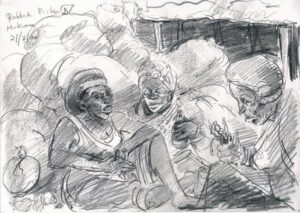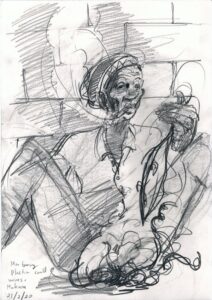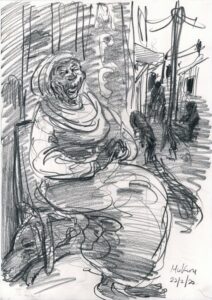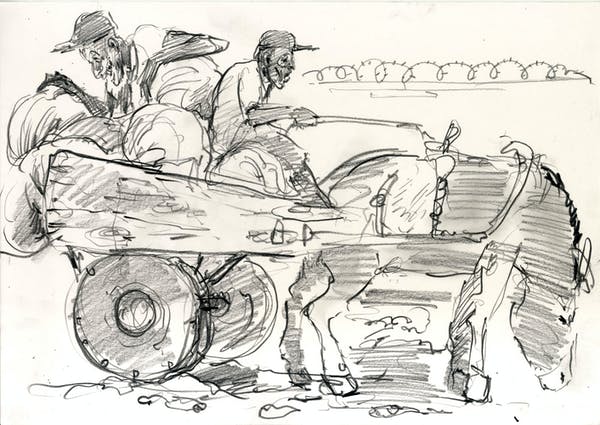Louis Netter
People are dying, critical resources are stretched, the very essence of our freedom is shrinking – and yet we are moved inward, to the vast inner space of our thoughts and imagination, a place we have perhaps neglected. Of all the necessities we now feel so keenly aware of, the arts and their contribution to our wellbeing is evident and, in some ways, central to coronavirus confinement for those of us locked in at home. For some, there are more pressing needs. But momentary joys, even in dire circumstances, often come through the arts and collective expression.
As a lecturer in illustration, I am constantly encouraging students to find an artistic voice and identify, in this crowded world of images, some touchstones to develop their own aesthetic. Art critic and theorist John Berger identified, in the act of drawing, something that is inherently autobiographical – a continual process of refining vision which moves us towards new understandings about ourselves and the world around us.
In this time of crisis and isolation, the role of art becomes more central to our lives, whether we realise it or not. We can easily take for granted the grand buffet of media that is available to us – and I can be guilty of a lack patience when students find it difficult discerning quality amid a sea of memes and amateur artistic indulgence which, to the unsuspecting, can appear to be worthy. The lack of curation on the internet frustrates people like me who value culture and its contribution and equally, are quickly becoming grumpy old men and women.
Whether we like it or not our consumption habits – including media – form who we are, our values, our inclinations. They are a patchwork of beliefs that are also tested in these difficult times.
Art can set you free
I was a high school teacher in Sleepy Hollow, New York, 20 miles away from ground zero when the 9/11 attacks happened. It was a time like now that tested our collective ability to make sense of a new normal and to mourn for the time before that would never come back. A schism in the collective consciousness that everyone struggled to frame, even artists.
Art Speigelman’s graphic novel In The Shadow of No Towers was less of a coherent narrative about 9/11 than an attempt to reassemble his own psyche through the comfort of his own creations and the medium of the comic itself.
People on social media are sharing favourite Netflix playlists, songs, videos and even artwork to reach out beyond isolation and share what they love. It is naive to think that such lists are mere casual swaps of entertainment enjoyed and recommended. They are an externalisation of the personality of the list maker: the romance enthusiast, the lover of comedies, the thrill seeker, the horror fan, and the aficionado of obscure documentaries.

People on social media are sharing favourite Netflix playlists, songs, videos and even artwork to reach out beyond isolation and share what they love. It is naive to think that such lists are mere casual swaps of entertainment enjoyed and recommended. They are an externalisation of the personality of the list maker: the romance enthusiast, the lover of comedies, the thrill seeker, the horror fan, and the aficionado of obscure documentaries.
People on social media are sharing favourite Netflix playlists, songs, videos and even artwork to reach out beyond isolation and share what they love. It is naive to think that such lists are mere casual swaps of entertainment enjoyed and recommended. They are an externalisation of the personality of the list maker: the romance enthusiast, the lover of comedies, the thrill seeker, the horror fan, and the aficionado of obscure documentaries.

People on social media are sharing favourite Netflix playlists, songs, videos and even artwork to reach out beyond isolation and share what they love. It is naive to think that such lists are mere casual swaps of entertainment enjoyed and recommended. They are an externalisation of the personality of the list maker: the romance enthusiast, the lover of comedies, the thrill seeker, the horror fan, and the aficionado of obscure documentaries.
We are now seeing this unfold and I worry for all of those people living in such close proximity. Self-isolation and the sharing of Netflix lists is an absurd luxury to the people here who live confined in small, steel shacks. Life was hard before COVID-19. After, it could be unbearable.

We are now seeing this unfold and I worry for all of those people living in such close proximity. Self-isolation and the sharing of Netflix lists is an absurd luxury to the people here who live confined in small, steel shacks. Life was hard before COVID-19. After, it could be unbearable.
We are now seeing this unfold and I worry for all of those people living in such close proximity. Self-isolation and the sharing of Netflix lists is an absurd luxury to the people here who live confined in small, steel shacks. Life was hard before COVID-19. After, it could be unbearable.
Source: The Conversation

